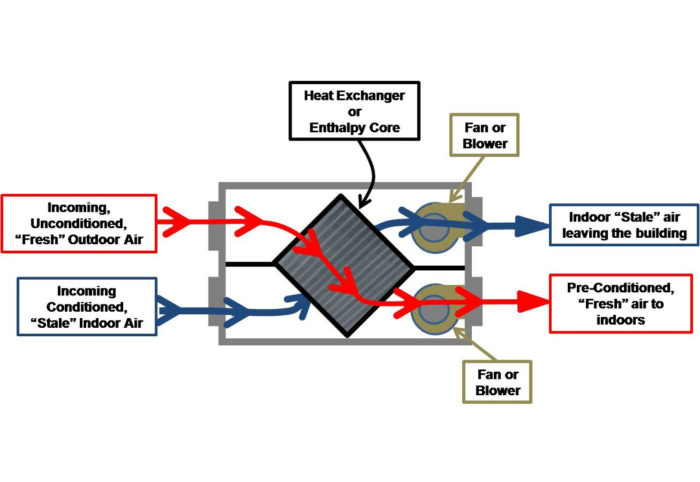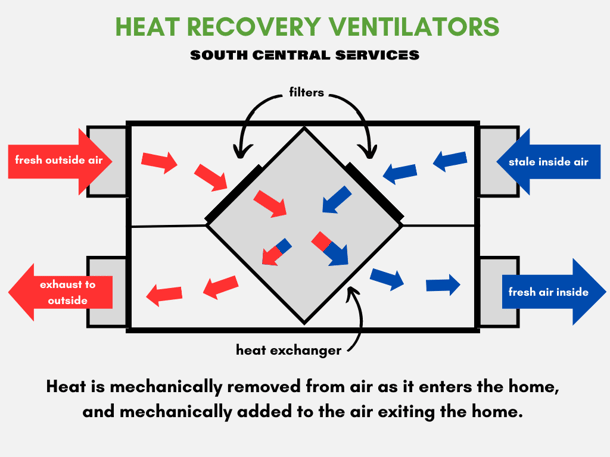Top FAQs About HRV Explained
Wiki Article
Exactly How Heat Recovery Ventilation Improves Indoor Air Top Quality and Reduces Energy Prices
Heat Recovery Ventilation (HRV) systems play an important duty in enhancing indoor air quality while all at once decreasing energy expenses. By efficiently trading stagnant indoor air with fresh outdoor air, HRVs help preserve optimal moisture and lower pollutants. Furthermore, their capability to recoup warm from outward bound air decreases the pressure on heating and cooling down systems. As energy expenses proceed to increase, recognizing the complete capacity of HRV systems ends up being increasingly important for homeowners and companies alike.Recognizing Heat Recovery Ventilation Systems

Heat recovery ventilation (HRV) systems play a crucial role in boosting interior air quality, particularly in modern-day, energy-efficient buildings. These systems are designed to move warmth from the outgoing stagnant air to the incoming fresh air, thus reducing power loss while keeping ideal temperature level levels inside. HRVs include a warmth exchanger, fans, and ductwork, assisting in the continuous flow of air. By expelling indoor pollutants and introducing fresh air, HRVs aid to balance moisture levels, avoid mold development, and lower irritants. The effectiveness of HRV systems hinges on their capability to recoup up to 80% of the warm from the worn down air, promoting energy conservation while making certain a healthy and balanced interior atmosphere. Their integration is vital in achieving sustainable living practices.
The Importance of Indoor Air Quality
Indoor air quality (IAQ) is an essential element influencing the health and wellness and health of owners in any type of setting. Poor IAQ can result in numerous health issues, consisting of respiratory system problems, allergies, and fatigue. Additionally, it can intensify status quo such as asthma. Factors adding to reduced IAQ include toxins from interior resources like cleansing agents, mold, and poor air flow. As a result, keeping good IAQ is important for advertising a secure and comfy living or working area. Reliable methods to enhance IAQ involve regular tracking of air quality, appropriate ventilation systems, and minimizing the usage of hazardous substances inside. By prioritizing IAQ, people can ensure a healthier atmosphere that cultivates productivity and total lifestyle.Power Effectiveness Advantages of HRV Equipments
Numerous homeowners and building managers are significantly recognizing the power effectiveness benefits of warm healing air flow (HRV) systems. By transferring warm from worn down indoor air to incoming fresh air, HRV systems substantially minimize the energy needed for heating & cooling. This procedure minimizes reliance on standard heating and cooling systems, resulting in reduced energy expenses. Additionally, HRVs assist keep a well balanced indoor climate, preventing excessive home heating or cooling down demands. The capability to recover approximately 90% of the warmth from outward bound air additionally supports sustainability initiatives by lowering total power usage. HRV systems contribute not just to cost financial savings yet also to a reduced carbon footprint, lining up with the expanding focus on energy-efficient building techniques.Installation and Maintenance Considerations
The reliable application of heat recovery air flow (HRV) systems requires mindful factor to consider of setup and upkeep factors to assure peak efficiency. Appropriate positioning of the HRV unit is vital, as it needs to be installed in a place that takes full advantage of airflow while minimizing noise disturbance. Furthermore, ductwork must be properly sized and protected to stop power loss. Regular maintenance, including filter substitute and system cleansing, is critical to safeguard optimal functionality and indoor air quality. Proprietors ought to establish a regular maintenance schedule to recognize and attend to potential issues before they escalate. Partnership with skilled professionals during both installation and maintenance stages can improve the long life and effectiveness of HRV systems, ultimately bring about better interior settings and lowered energy prices.
Real-World Applications and Success Stories
Discovering real-world applications of warm healing ventilation (HRV) systems discloses their substantial impact on indoor air high quality and power efficiency throughout different setups. In domestic structures, home owners have actually reported improved air top quality, resulting in fewer allergic reactions and breathing concerns. Schools executing HRV systems have noted boosted pupil focus and reduced absenteeism because of much better air flow. Commercial buildings, such as offices and retail spaces, have actually experienced lower energy expenses and enhanced employee efficiency. For example, a corporate workplace in a warm climate achieved a 30% reduction in energy costs after setting up an HRV system. These success tales demonstrate that HRV innovation not just contributes to much healthier environments but additionally offers substantial economic advantages, making it an important financial investment for different sectors.Often Asked Concerns
Can HRV Equipments Decrease Irritants in Indoor Air?
The efficiency of HRV systems in decreasing interior irritants primarily depends upon their HRV Heat Recovery Ventilation ability to filter and exchange air. HRV Heat Recovery Ventilation. By continually changing stagnant air, these systems can considerably decrease allergen levels throughout indoor settings
Exactly How Does Moisture Affect HRV System Efficiency?
Moisture considerably influences HRV system performance; high levels can bring about condensation, lowering effectiveness, while reduced humidity might improve air exchange. Balancing moisture is crucial for suitable procedure and keeping interior air top quality.Are HRV Systems Noisy During Operation?
HRV systems can generate varying sound levels during procedure, depending on their design and setup. Some devices run silently, while others might produce recognizable audio, particularly at higher air flow settings or when inadequately preserved.What Is the Ordinary Lifespan of an HRV System?

Can HRV Systems Be Used in All Environments?
HRV systems can be made use of in various environments, yet their performance might vary - HRV Heat Recovery Ventilation. In severe temperatures, changes or additional systems may be required to assure ideal efficiency and convenience while maintaining interior air top qualityReport this wiki page